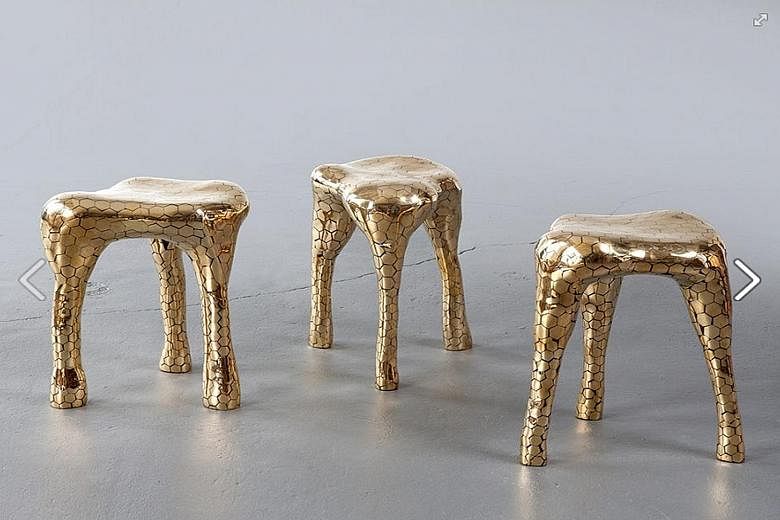NEW YORK • Ms Jeanne Greenberg Rohatyn, owner of the New York gallery Salon 94 and a prolific private art collector, buys mostly "living artists", she says. "Marilyn Minter, David Hammond, Richard Prince."
She also buys design objects - couches, chairs, tables and home decoration - that match. "The idea of collecting or living with furniture from the same generation of artists was interesting to me," she says.
She started to buy design slowly, she says, though over the past decade, her pace of acquisitions has quickened.
At this point, her house is filled with high-end design, which generally describes furniture or home objects that cost at least several thousand dollars.
A "Sequins" mirror by the mid-century designer Line Vautrin from 1961 sold in June at Phillips in New York for US$137,000 (S$193,217), for instance.
Her collecting habits are a symptom of an exploding high-end design market, wherein such stars as the Haas brothers, fraternal twins born in 1984, sell their shiny metallic "Hex" stools for US$30,000.
Three years ago, the same stool sold for US$3,000, says Mr Zesty Meyers, a co-founder of R & Co, a TriBeCa design gallery that represents the brothers. "We must have sold six of them in the first week," he says.
Another one of R & Co's artists is Brooklyn's Jeff Zimmerman, who makes large-scale brass chandeliers replete with hand-blown light fixtures that start at US$125,000.
Eight years ago, Meyers says, the same pieces sold for just US$10,000.
"What makes Jeff so successful?" he asks. "When he gets inside the space, the starchitect has already built the dwelling, the art collection is most likely already in place and the decorator has already decorated," he says. "Jeff is the glue between those things."
Even as design prices skyrocket - a sideboard by Paolo Buffa sold for £40,000 (S$86,234) above a high estimate of £15,000 last month at Phillips London - the equivalent art market is growing even faster.
The market for 20th-century and contemporary art reached an unprecedented €9.2 billion (S$13.9 billion) last year, according to the Tefaf (The European Fine Art Fair) Art Market Report, which has helped to create the perception that design is still a bargain.
"Yes, design is pricey," says Ms Greenberg Rohatyn.
"But it's not as pricey as art." This notion - that design is both a bargain and, increasingly, an essential part of an art collector's home - has fuelled growth in contemporary design galleries around the globe.
Carpenter's Workshop Gallery, which was founded in London in 2006 and opened a branch in Paris in 2011, has just opened a sweeping showroom on the top two floors of New York's Takashimaya building on Fifth Avenue.
"People want exceptional high-end furniture that's going to match the quality of what they have on the walls," says Mr Loic Le Gaillard, who co-founded the gallery, which shows artists such as Wendell Castle, whose work can sell for more than US$300,000.
Despite record growth, the market remains comparatively tiny. Mr Le Gaillard, for instance, estimates that he has between 200 and 300 regular buyers.
Mr Meyers says that he will write around 700 invoices this year.
Compare that to the art market, where approximately 1,530 lots sold for over €1 million last year, around 96 of which sold for more than €10 million, according to the same Tefaf report.
Mr Le Gaillard also partially credits the boom in the design market to a boom in design coverage.
Ms Suzanne Demisch, a co-founder of the New York gallery Demisch Danant, which specialises in mid- century French design, represents furniture designers such as Maria Pergay, whose work ranges from US$15,000 to US$500,000, depending on the object and the year it was produced. She cautions against making direct comparison between the art and design markets.
"They're two different things," she says. "A lot of things drive a price for a design object," she says. "It's new to the market, there're more players, if something's trending and there's a limited supply, and there's also a sheep mentality, where if all of your friends have it, you want it."
BLOOMBERG

